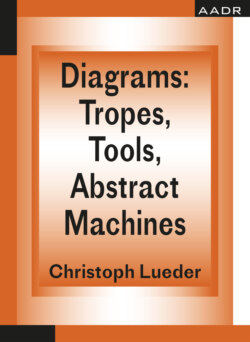Diagrams: Tropes, Tools, Abstract Machines

Реклама. ООО «ЛитРес», ИНН: 7719571260.
Оглавление
Christoph Lueder. Diagrams: Tropes, Tools, Abstract Machines
Отрывок из книги
Diagrams: Tropes, Tools, Abstract Machines
Christoph Lueder
.....
The multiplicity of disciplinary and historical tropes and trajectories, the flow of travel from conceptualisation to actualisation and vice versa, interact with further layers to constitute a complex methodological field, an unbounded fabric woven from specialist territories, interstices and overlays. This monograph assembles an array of deep probes into this paradoxical field, taken at key coordinates and intersections of ideas, practices and conven8 tions. Each probe—each monograph chapter— adopts a diagrammatic method as point of departure to retrace transactions between authors and commentators across disciplines, situate discourses and methods within cultural and disciplinary milieus, examine rapport with corporeality and embodied practices, map out analytical and speculative usages unlocking critical and inventive potentials.
Chapter one, on Poché and Free Section, explores the Beaux Arts notion of poché as a nexus between embodied thought, representational convention and inventive potential. Its literal translation from French is “pocket;” at the Ecole des Beaux Arts in Paris during the 19th century it denoted thick, sponge-like masonry walls that contained secondary spaces. The sectioned surface of such walls was hatched. At urban scale, poché manifests in the Nolli Map of Rome (1748, Figure 2), and diagrams relationships between public and private space. Since then, poché has been appropriated and reinterpreted in different ways: Rowe conceived of it as the imprint on the ground of heavy walls and principle of tectonic poïesis, Kahn recognised a principle of spatial hierarchy, with servant spaces contained as voids in the poché, Venturi theorised open poché that exposes those voids as volumes; leading up to Koolhaas’ radical reinterpretation, inverting poché from its early 20th century role as antagonist of the Corbusian free plan to protagonist of a newly theorised free section.
.....